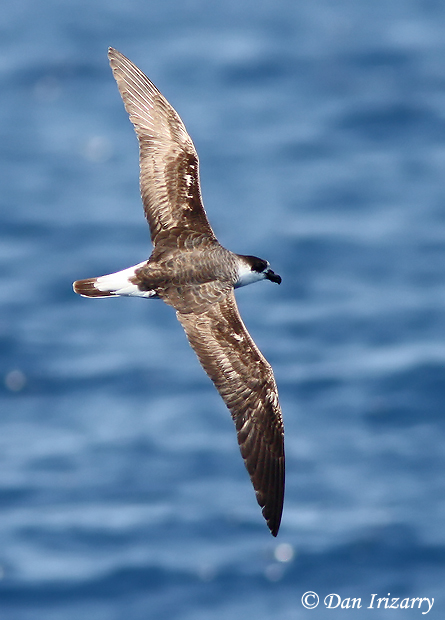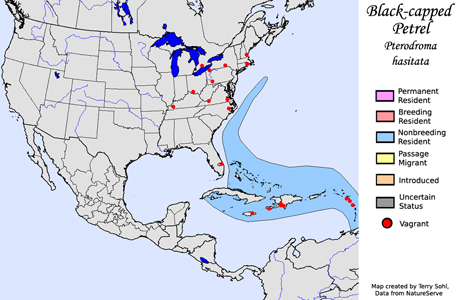| Length: 16 inches | Wingspan: 36 inches | Seasonality: Non-resident in South Dakota |
| ID Keys: Dark upperwings and back, white "rump", white underparts and head with black "cap", white underwing with black edging and diagnostic black band | ||
 The
Black-capped Petrel was once a relatively common seabird around the
Caribbean. However, in the 1800s birds and their eggs were harvested,
and in conjunction with the introduction of rats and other predators to
their nesting colonies, populations declined precipitously. The once
widespread species is now thought to be holding on only in a few breeding
sites on the island of Hispaniola (Dominican Republic and Haiti). A
dark-colored phase of the bird, known as the "Jamaican Petrel", is likely
now extinct. Their colloquial name is the "Diablotin", so named for their
haunting, "devilish" nighttime calls on the breeding grounds.
The
Black-capped Petrel was once a relatively common seabird around the
Caribbean. However, in the 1800s birds and their eggs were harvested,
and in conjunction with the introduction of rats and other predators to
their nesting colonies, populations declined precipitously. The once
widespread species is now thought to be holding on only in a few breeding
sites on the island of Hispaniola (Dominican Republic and Haiti). A
dark-colored phase of the bird, known as the "Jamaican Petrel", is likely
now extinct. Their colloquial name is the "Diablotin", so named for their
haunting, "devilish" nighttime calls on the breeding grounds.
Habitat: Breeds on cliffs and steep forested slopes on islands in the Caribbean. Non-breeding birds are found at sea, but can sometimes be found relatively close to shore.
Diet: Feeds on squid and small fish.
Behavior: Feeds by flying near the ocean's surface, dipping down and pattering their feet on the water as they grab prey. They will also sometimes swim on the ocean's surface and reach down to grab prey.
Nesting: The nest of a Black-capped Petrel is a burrow in the soil, excavated by the parents. A single egg is laid. Both parents help to incubate the egg, and tend to and feed the young after hatching.
Interactive eBird Map: Click to access an interactive eBird map of Black-capped Petrel sightings
Song: Usually silent away from the breeding grounds. On the breeding grounds, noted for its haunting calls, most often heard at night (hence the "Diablotin" nickname).
Migration: Breeding is now thought to be confined to the high mountains of the Dominican Republic and Haiti. Non-breeding birds are also concentrated in the Caribbean, but can also be found off the Atlantic Coast of the U.S., and rarely wander far across the Atlantic towards Europe and Africa. Storm events have occasionally pushed individual birds far inland, with inland records across several eastern U.S. states.
Similar Species: Similar plumage to several Shearwater species that are found at times near North America, with dark plumage above and lighter plumage below. In flight, the white rump and black band on the underwing are diagnostic. The white neck and black cap are also diagnostic when comparing to other Petrel species, but they could be confused with the Bermuda Petrel, Herald Petrel, or Fea's Petrel.
Conservation Status: Populations have declined drastically since 1800. Collection of birds and their eggs, and introduction of rats and mongoose to nesting areas caused their initial declines, and the species has yet to recover. They have been extirpated as breeding birds on several islands where they formerly bred. The IUCN lists the Black-capped Petrel as "Endangered".
Further Information: 1) Audubon.org - Black-capped Petrel
2) OceanWanderers.com - Black-capped Petrel
3) U.S. Fish and Wildlife Status Report - Black-capped Petrel
Image Information: Photo taken by Dan Irizarry - Photo taken on May 21st, 2011 off the coast of North Carolina. Photo licensed under Creative Commons Attribution-NonCommercial-ShareAlike 2.0 generic license.
| Click below for a higher-resolution map |
 |
| South Dakota Status: Non-resident in South Dakota. |
Additional Black-capped Petrel Photos (coming soon!!)
